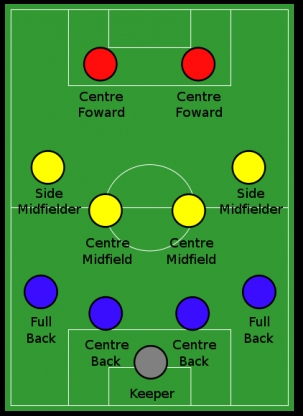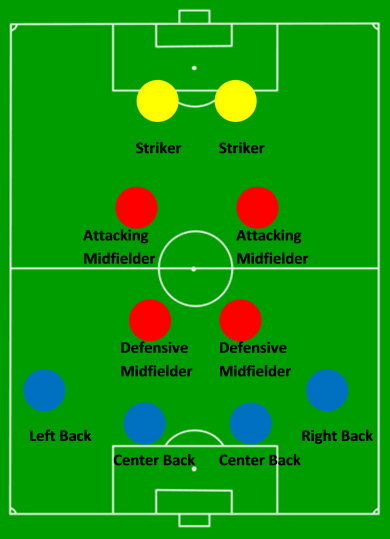

I play PES and FIFA with a friend who used to, without fail, use the default formations and slot names into positions. Then one day, after my lowly Wolves team beat his mighty Barcelona (OK, he wasn’t that good, but still), he crossed over to the dark side. Now sometimes our pre-game strategizing takes longer than the games themselves.
The point of this little anecdote is that setting up your team’s formation is one of the most overlooked things in football video games. You can have a lot of fun — geeky fun, nonetheless —tinkering with formations and getting the best out of your players. And as a bonus, you can also mastermind some unlikely victories in the process.
Firstly, a few disclaimers: This is not a tactics masterclass for two reasons. One, I’m not terribly bright. And two, we’re talking about video games. No matter their progress, at the end of the day the football we play on consoles is nothing like the football we see on TV. These games are still heavily tilted towards the gamer’s skills as opposed to their tactical understandings. Plus the AI is still nowhere smart enough to recognize and replicate the intricacies of each tactic.
What this is, is a starter’s guide to get you on your way to thinking and experimenting with different tactics. This article barely scratches the surface of each formation’s strengths and weaknesses. And as always, there are exceptions to the rule, so if I suggest that certain tactics are good for teams with certain styles, and you happen to disagree, by all means give it a try anyway. Either way, when you get your tinkering right and see the effects on the field, it’s a very satisfying feeling.
Before The Numbers
Before you decide on your formation, consider these factors: how agressive do you want to be? Do you want to pressure your opponent high up the pitch, or sit back and hit them on the counter? Do you want to be slow and methodical with your possession, or quick and incisive, hitting them from wide? Certain formations favor certain strategic approaches.
At the end of the day, the goal for each formation remains the same: to create space in dangerous places. Some do it by overloading players in a certain area, and others do it by positioning players between the lines — like an attacking midfielder that plays between the midfield and defense. This means that, aside from the few overpowered formations that seem more intent on exploiting FIFA's or PES' engine’s weaknesses more than playing football, there are no “automatic win” formations. You must consider your opponent’s formation before deciding which one to employ for your own team.
The Numbers
The numbers (4-4-2, 4-3-3, etc.) indicate the amount of players in each phase of play. At its most basic, they are divided in threes, indicating defense, midfield, and forwards. However, there are some more intricate variations that further distinguish between attacking and defending midfielders (like the 4-2-2-2). But the general rule is that the first number refers to the amount of defenders, and the last number refers to the amount of strikers.
Most of the time, these numbers are just numbers. For most formations they are a lot more fluid than suggested. For example, in a 4-4-2, defending is not just done with four players. What these numbers do, however, is give a general impression of where a team’s emphasis are by the amount of players they are fielding in each phase of play.
The Formations

A good old British formation, the 4-4-2 relies heavily on partnerships. One of the most crucial partnerships, especially in video games, is between your fullback and your wing. Because of the balanced spacing inherent in a 4-4-2, it creates a lot of space down the wide areas where your wide players can use to good effect. It’s great for teams with wingers who pace and tall strikers, as you can whip crosses from wide until the sun goes down in a 4-4-2. It's a very organized formation where players move forwards and backwards in a unit, meaning that teams without that star player may be able to get by with a 4-4-2 based solely in industry.
The disadvantage of 4-4-2, as anybody who watched Fabio Capello’s England in the 2010 World Cup can attest, is it's rigidity. Because of its separation into effectively three bands of play (defense, midfield, strikers), the formation is very vulnerable against teams playing with players who play “between the lines.” Attacking midfielders, for example, have a tremendous advantage playing against a 4-4-2, because their starting position is "in the hole" between the midfield and defense line -- or simply in space. They force a defender to play higher up than ideal, or a central midfielder to play further back, which in either case disrupts the crucial central partnerships by sucking players out of position.
Also on attack, the 4-4-2 plays to one of FIFA’s AI weakness — that sometimes players are reluctant to come meet the ball. Inherently a formation that forces players to spread the field, this can sometimes lead to teammates being too far apart to pass to, especially if your opposition puts you under pressure.
Good for: Teams with pacy wingers and target men; mediocre teams without a star player.
Bad for: Playing against a more fluid formation, especially one that incorporates an attacking midfielder.
Try the 4-4-2 with: Stoke City, where you can whip balls into the box all day long to a tall target man like Peter Crouch.

The diamond is a particular variation of the 4-4-2 that positions its midfielders in a diamond shape, as opposed to a flat four. Because the midfield is no longer in a straight line, it's slightly less rigid than the regular 4-4-2. It’s usually a narrow diamond where instead of wingers, we see two more center midfielders forming the two wide corners. Rarely is the formation played with wingers, because with that large gap in the middle, your midfield will get overrun on defense.
The diamond is great for a team with lots of firepower, as it can effectively stretch play and create plenty of space in dangerous areas. Your strikers can drift wide to draw defenders and create space for attacking midfielders to roam into (Frank Lampard's late runs into the box is a great example). The two middle midfielders in the diamond can support the attack, while the player positioned at the bottom tip can recycle possession or intercept passes when on defense.
I prefer to use this formation with mobile strikers — especially those who play as a second striker (or CF in FIFA) — because they’re usually more agile and well rounded, and can stretch play and create opportunities more effectively than a classic number nine striker could.
Good for: Teams with good a attacking midfielder and creative forwards.
Bad for: Teams with aerial threats, as most attacks will initially start down the middle until help arrives from the fullbacks.
Try the 4-4-2 Diamond with: AC Milan, where multi-talente forwards like Ibrahimovic and Pato can do the damage while solid midfielders like van Bommel and Seedorf protect the backline.

One of my pet peeves in PES is that they tend to label too many formations as 4-2-2-2. To me, this is a specialized box formation (notice the middle four players forming a box) where the only wide players, strictly speaking, are the full backs. Midfield is one where it works well in real life, but not so much in video games because it depends a lot on the intelligent movements of players. While PES has undoubtedly made some huge strides this year, I find that players’ movements are still too restricted within their assigned position.
Nonetheless, if you do want to have a go with this, the box midfield is a short passing formation which relies heavily on the attacking midfielders. They are usually creatively and technically skilled playmakers who drift into space and create havoc by sucking defenders — usually opposition fullbacks — out of position, allowing your own fullbacks to storm down the flanks. If used properly, the 4-2-2-2 can be a perfect counter to a more rigid formation like the 4-4-2, because of its ability to exploit the space between the bands.
The main difference between the diamond and the box is that the roles in a box midfield are more rigidly defined. The defensive two in the box are there to break up play, while the attacking two have to be creatively and technically brilliant players who can make things happen.
The drawback of the box formation, aside from the fact that they just don’t translate too well in video games, is that defensively, the strikers and attacking midfielders don’t contribute much. This can be a problem when playing other similarly offensive formations, basically turning the match into a shootout.
Good for: Teams with fast, marauding fullbacks, and creative attacking midfielders.
Bad for: Teams with height. Like the diamond, the 4-2-2-2 is best for teams that play short balls and look to slice through defences.
Try the 4-2-2-2 with: Brazil, just for the historical significance. Well, that and apparently they have some decent midfielders and forwards hanging around.
Stay tuned for Part 2 of our formations guide coming up tomorrow!




 NHL 10: Goalie Guide
NHL 10: Goalie Guide The Basics of Reading a Defense in Madden NFL 12
The Basics of Reading a Defense in Madden NFL 12 NCAA Football Defensive Strategy: Cornerback
NCAA Football Defensive Strategy: Cornerback OS Tip of the Day: Equipment Makes the Difference (Tiger 13)
OS Tip of the Day: Equipment Makes the Difference (Tiger 13) NBA 2K13: Six Best Role Players for Your Association
NBA 2K13: Six Best Role Players for Your Association